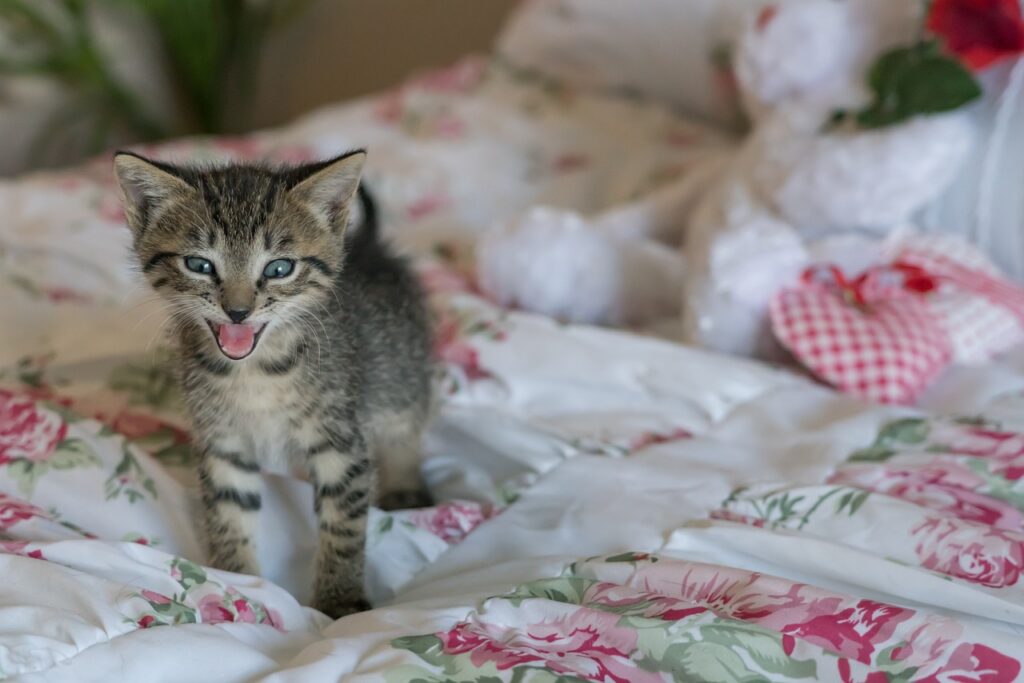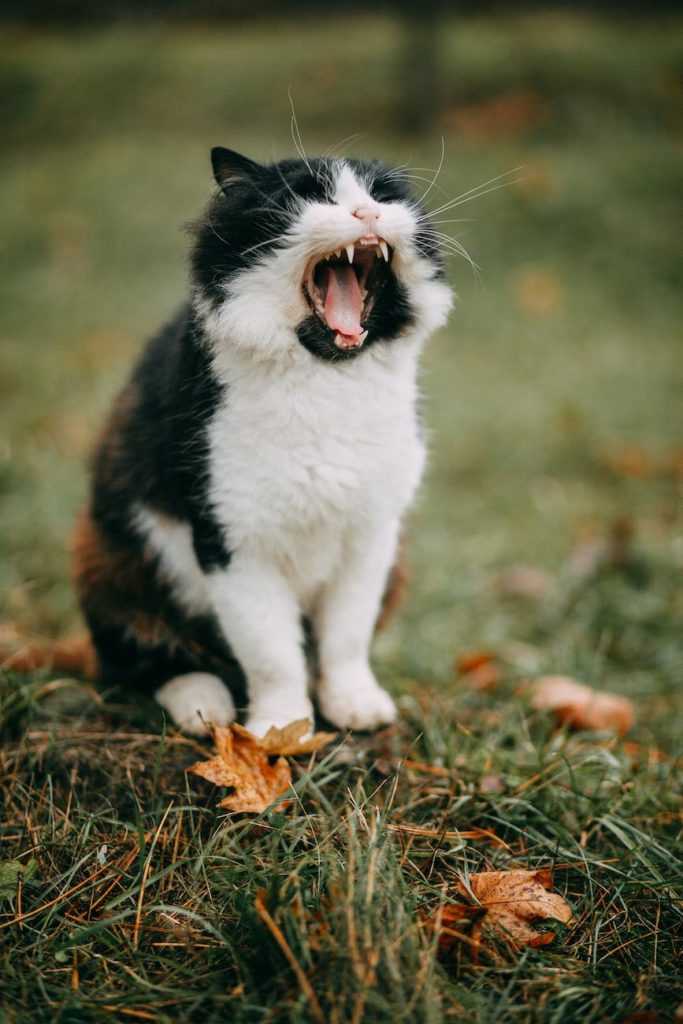Why Your Cat is Growling
As a cat owner, you may have noticed your furry friend growling from time to time. While growling is more commonly associated with dogs, cats can also make this vocalization. But why do cats growl, and what does it mean? In this article, we’ll explore some of the reasons behind this behavior and provide some insights for cat owners.

Table of Contents
10 Powerful Reasons Why Your Cat is Growling and How to Turn it Into a Positive Experience
Cats have always been mysterious creatures, captivating our hearts with their unique personalities and behaviors. One such behavior that often raises eyebrows is growling. While many cat owners may feel alarmed or confused when their feline friend issues a low, throaty growl, understanding the reasons behind this vocalization can help turn what may seem like a negative experience into a constructive one. In this blog post, we will explore “Why Your Cat is Growling” and provide strategies to transform this behavior into a more positive interaction.
1. Understanding the Language of Growling
When your cat growls, it’s essential to recognize that this vocalization is a form of communication. Unlike purring, which usually signifies contentment, growling often indicates stress, discomfort, or a need to assert boundaries. Why Your Cat is Growling. Understanding this language is crucial for cat owners who want to create a harmonious relationship with their furry companions.
Focus on your cat’s body language while they growl. Pay attention to their posture, ears, and tail position. If their ears are back, body tense, and tail flicking, they might feel threatened. By observing these signs, you can start to understand the context of the growl and respond appropriately.
2. Territorial Disputes and Resource Guarding
Territorial instincts are deeply ingrained in felines. When your cat growls, it might be signaling that they feel their territory is being threatened. Why Your Cat is Growling. This situation is especially common in multi-pet households. Your cat may perceive another pet or even a human as an intruder in their space, leading to growling as a way to assert dominance.
To turn this negative experience into a positive one, ensure that each pet has its own space and resources, like food bowls, litter boxes, and resting areas. This distribution allows each animal to feel secure in its territory. Why Your Cat is Growling. You can also introduce new pets gradually, using positive reinforcement to create a sense of safety and reassurance.
3. Pain or Discomfort Alerts
Sometimes, the reason behind growling can be as simple as discomfort or pain. Why Your Cat is Growling. Cats are experts at hiding their pain, but growling may surface as a vocal warning when they are experiencing distress. A sudden growl can signal injury, an underlying medical condition, or even discomfort from external factors like a new collar or harness.
It is crucial to monitor your cat’s health closely. Why Your Cat is Growling. If growling becomes frequent or is accompanied by other signs like lethargy or changes in appetite, it may be time for a visit to the veterinarian. Addressing any underlying health concerns promptly can help decrease the growling behavior in your cat and can make for a healthier, happier pet.
4. Fear and Anxiety Triggers
Another common reason your cat may be growling is fear. Loud noises, unfamiliar environments, or the presence of strangers can trigger anxiety in your feline friend. Growling serves as a warning to perceived threats, indicating either a desire to flee or defend against the source of fear.
Creating a safe space for your cat can significantly mitigate anxiety-driven growling. Why Your Cat is Growling. Provide a quiet corner of your home with cozy bedding, toys, and hiding spots where they feel secure. Slowly introduce your cat to new experiences while offering positive rewards, like treats or affection, to help them associate these situations with positive outcomes.
5. The Role of Play and Hunting Instincts
Cats are natural hunters, and growling can occur during play as they engage their predatory instincts. Why Your Cat is Growling. This type of growling may sound different than the fearful or territorial growl and is often accompanied by play-fighting or stalking behavior. Understanding this context is key to creating a positive outcome from growling during playtime.
Engage your cat with interactive toys that simulate hunting behavior, like feather wands or laser pointers. Why Your Cat is Growling. Allow your cat to exhibit their instincts during scheduled play sessions. This not only provides a constructive outlet for their energy but can also deter growling when play becomes too intense. Ensuring the playtime is enjoyable will create a positive association with growling during these moments.
6. Socialization and Communication Challenges
Some cats are naturally more vocal than others, and growling can sometimes signify challenges in communication or socialization. Why Your Cat is Growling. This growling may emerge during various interactions—with other pets or even with people—especially if the cat feels overwhelmed or lacks the necessary social skills to navigate these encounters effectively.
To help your cat develop better social skills, consider organizing playdates with other well-socialized pets that exhibit friendly behavior. Gradually introducing your cat to different environments, positive interactions, and various new people can significantly enhance their communication skills over time. Additionally, providing enriching experiences, such as exploring new spaces or participating in engaging activities, can aid in boosting their confidence. Why Your Cat is Growling. Remember to practice patience throughout this process, as each positive experience will help your cat acclimate to social situations, potentially reducing growling behavior and fostering a more harmonious atmosphere during interactions. Consistency is key to nurturing their social capabilities.
7. The Importance of Routine and Environment
Cats are creatures of habit, and any disruptions in their routine can lead to stress and anxiety, often resulting in behaviors like growling. If your cat has experienced recent changes, such as moving to a new home, the introduction of a new family member, or even alterations in feeding times, these factors can deeply affect their sense of comfort and security. Why Your Cat is Growling. Changes disrupt their familiar patterns, leading to feelings of uncertainty.
To reduce anxiety in your feline friend, it is crucial to maintain a consistent routine for feeding, playtime, and even litter box cleaning. Predictable schedules help your cat feel secure in their environment and understand what to expect throughout the day. Why Your Cat is Growling. Additionally, enriching their living space is essential. Consider incorporating climbing structures, scratching posts, and safe hiding spots to provide them with options for both comfort and exploration.
Engaging your cat with interactive toys can also boost their confidence and reduce stress levels. Remember, a well-structured environment fosters a sense of safety, allowing your cat to thrive and exhibit positive behaviors. Why Your Cat is Growling. By paying attention to their needs and maintaining stability in their daily lives, you build a stronger bond and create a happier, healthier cat.
8. Building Trust Through Positive Reinforcement
Whenever a growl occurs, it’s essential to assess the situation with empathy and patience. Instead of reacting negatively to the growl, focus on building trust with your cat through positive reinforcement. Why Your Cat is Growling. Reward them with treats, praise, or gentle petting when they display calm behavior, especially during situations that typically trigger growling.
Training your cat to respond to commands can also lead to increased trust and confidence. Teaching them to associate particular commands with positive outcomes can ease anxiety in various situations, reducing growling and subsequently encouraging a more harmonious interaction between you and your cat.
9. Consulting with Professionals
If you find that your cat’s growling persists, or if it escalates throughout a range of situations, it may be beneficial to consult with a veterinarian or an animal behaviorist. Why Your Cat is Growling. These professionals can provide tailored advice based on their expertise and can help diagnose any underlying issues contributing to the growling behavior.
Approaching trained professionals can significantly shorten the learning curve when developing strategies to mitigate growling episodes. Why Your Cat is Growling. They can assess your cat’s behavior comprehensively and recommend measures ranging from health check-ups to environmental modifications, ultimately leading to a more peaceful home for both you and your cat.
10. Embracing the Growl: Acceptance and Understanding
Ultimately, it’s crucial to embrace the understanding that growling is a natural part of feline communication. Why Your Cat is Growling. By recognizing and respecting your cat’s vocalizations, you open avenues for a deeper relationship with your pet. It is essential to approach growling with compassion rather than judgment.
Encourage a dialogue with your cat, even if it initially feels one-sided. Show them that you are attentive to their needs and feelings. Over time, this acceptance will foster a more profound bond, transforming the growl from a source of alarm to a simple expression of your cat’s unique personality.
By understanding the reasons behind “Why Your Cat is Growling” and knowing how to address those moments positively, you can enhance your relationship with your feline friend. Through patience, empathy, and intentional interaction, you can create a positive atmosphere conducive to both you and your cat’s well-being.

Fear or aggression
Fear or aggression is a fundamental reason behind the growling of cats, which serves as a significant form of communication in the feline world. Why Your Cat is Growling. When a cat feels threatened or cornered—perhaps by an unfamiliar person, another pet, or sudden loud noises—it may instinctively growl to signal its discomfort and to deter the perceived threat. This vocalization acts as an audible warning, telling others to maintain their distance and respect its space.
In addition to fear-based growling, this behavior can also indicate aggression, particularly if it is accompanied by other aggressive actions such as hissing, swatting, or biting. Why Your Cat is Growling. These accompanying behaviors often serve to escalate the intensity of the growl, making it clear that the cat feels truly threatened or is ready to defend itself.
Understanding these vocal cues is crucial for cat owners, as misinterpretations can lead to misunderstandings and potential conflicts between the cat and its environment. By recognizing the early signs of fear or aggression, owners can take proactive steps to create a more secure and less stressful atmosphere for their feline companions. Why Your Cat is Growling. This attentiveness not only helps in mitigating conflict but also fosters a deeper bond and understanding between cats and their humans.
Pain or discomfort
Cats can also growl as a way to communicate pain or discomfort. This vocalization serves as a signal that something is amiss, alerting their owners to their distress. Why Your Cat is Growling. If a cat is experiencing physical discomfort or pain, such as from an injury or illness, it may growl when touched or moved. This behavior is particularly noticeable if the cat has suffered a recent trauma or is dealing with a disease that causes pain, such as arthritis. Growling can be a cat’s instinctual response to protect itself from further discomfort or to ward off perceived threats.
In some cases, cats may also growl when they are touched in a sensitive area, such as their belly or tail. These regions can be particularly vulnerable, and a cat may react defensively if it feels uncomfortable or threatened. Why Your Cat is Growling. Understanding these growls is essential for cat owners, as it can help them identify when their pet may need medical attention or a change in care. Observing other body language, such as flattened ears, narrowed eyes, or a twitching tail, can also provide additional context to their growling. Ultimately, recognizing a cat’s growl as a form of communication about pain is crucial for ensuring their well-being.
Territorial behavior
Territorial behavior is a fundamental aspect of a cat’s nature. Cats are inherently territorial animals, and they often exhibit various behaviors to defend and assert this territory. One of the most recognizable signs of territorial defense is growling. Why Your Cat is Growling. When a cat perceives another animal or even a person as a potential threat to its space, it may growl as a vocal warning, signaling that they should keep their distance. This growling is not just a random noise; it serves as a clear message of discomfort and a deterrent to intruders.
In multi-cat households, this behavior can become even more pronounced. Cats that share space with one another often feel the need to establish a hierarchy, leading to instances of growling to assert dominance or to communicate boundaries. Why Your Cat is Growling. One cat might growl to signal that it feels threatened or challenged by another, thereby clarifying its position within the household dynamic. The growling may also serve as a way to settle disputes or disagreements over resources such as food, toys, or resting spots. Understanding this territorial instinct is crucial for cat owners, as it can aid in creating a harmonious environment that accommodates the needs and personalities of each feline resident.
Defensive behavior
Cats may also growl as a defensive behavior when they feel threatened or scared. This instinctual response serves as a warning signal to potential threats, indicating that the cat is prepared to defend itself if necessary. Such behavior can be particularly noticeable in situations where a cat is cornered or trapped, feeling as though it has no other option but to growl as a way to assert its readiness to fight or flee. Why Your Cat is Growling. Growling is often accompanied by other body language cues such as flattened ears, puffed-up fur, and an arched back, further emphasizing the cat’s distress and desire for personal space.
This defensive vocalization can occur in various contexts, such as when a new pet is introduced into the home, during visits to the veterinarian, or if a cat encounters unfamiliar people or animals. The growl serves as a vocal barrier, communicating that the cat may become aggressive if the perceived threat does not back off. Why Your Cat is Growling. Understanding this behavior is crucial for cat owners, as it can help them create a safer and more comfortable environment for their feline companions. Addressing the underlying causes of a cat’s anxiety or fear can help mitigate such defensive behaviors over time.
Play behavior
Play behavior in cats is a fascinating aspect of their social interactions, particularly among younger cats and kittens. During playtime, these energetic felines engage in various activities that mimic hunting and predatory behaviors. Growling can often accompany these playful antics, serving as a form of communication that expresses excitement or enthusiasm. This vocalization is not typically aggressive but rather a playful indication of their heightened state of engagement.
Kittens, in particular, are notorious for their spirited play sessions, where they can be seen pouncing, chasing, and wrestling with one another. Growling adds an interesting layer to their play, signaling both their enjoyment and their instinctive drives. It’s important for cat owners to recognize that such sounds during play are generally harmless and part of healthy behavioral expression.
In these playful scenarios, growling often occurs alongside other sounds like chirps or soft meows, creating a symphony of playful noise. Why Your Cat is Growling. These vocalizations are essential in cat communication, helping to establish boundaries and excitement levels during their playtime duel. As they grow older, some cats might continue this playful growling, while others may become quieter, leaving behind the more intense sounds of their youth. Understanding this behavior can strengthen the bond between cats and their human companions.
Live Pee Free! Odor Eliminator 100% Eliminates Pet Odor on Contact. 20% Off. No Enzymes, No Fragrance, No Detergent, No Bleach – Safe for Kids and Pets.In conclusion, cats may growl for a variety of reasons, including fear, aggression, pain or discomfort, territorial behavior, defensive behavior, and play behavior. As a cat owner, it’s important to understand your cat’s body language and vocalizations and provide them with a safe and comfortable environment to thrive.

If you’re a cat owner and want to learn more about how to provide the best care for your feline friend, be sure to visit our website for more helpful tips and information.



